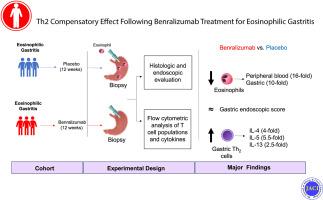TH2 cell compensatory effect following benralizumab treatment for eosinophilic gastritis
IF 11.4
1区 医学
Q1 ALLERGY
引用次数: 0
Abstract
Background
Eosinophil accumulation is a main feature of eosinophilic gastritis (EoG) and is associated with its histologic diagnosis and pathology. However, a recent clinical trial has demonstrated that EoG endoscopic, noneosinophil histologic, and clinical features remain persistent despite complete eosinophil depletion.
Objective
Our aim was to examine gastric T-cell composition and associated cytokine levels of patients with EoG following benralizumab-induced eosinophil depletion versus following administration of placebo.
Methods
A cohort of subjects with EoG from a subset of subjects who participated in a recent phase 2 benralizumab trial was treated for 12 weeks with administration of 3 doses of benralizumab (anti–IL–5 receptor α antibody [n = 5]) or placebo (n = 4). Single-cell suspensions obtained by gastric biopsy were stimulated with phorbol 12,13-dibutyrate and ionomycin in the presence of brefeldin A and monensin. Harvested cells were fixed, stained, and analyzed by flow cytometry to examine T-cell populations and associated cytokines.
Results
Following benralizumab treatment but not placebo, blood and gastric eosinophil levels decreased 16-fold and 10-fold, respectively. Whereas histologic score and features were significantly decreased, no change was observed in endoscopic score and features. Following complete eosinophil depletion with benralizumab, gastric TH2 cell levels were 3-fold higher than the levels in the patients with EoG who were given placebo; and the levels of associated type 2 cytokine production of IL-4, IL-5, and IL-13 in the benralizumab-treated patients were, respectively, 4-, 5.5-, and 2.5-fold, higher than those in the placebo-treated patients.
Conclusion
We have identified a putative positive feedback loop whereby eosinophil depletion results in a paradoxic increase in levels of TH2 cells and derived cytokines; this finding suggests an explanation for the limited success of eosinophil depletion as monotherapy in eosinophil-associated gastrointestinal disorders.

本拉珠单抗治疗嗜酸性胃炎后的 Th2 补偿效应
背景:嗜酸性粒细胞聚集是嗜酸性粒细胞性胃炎(EoG)的主要特征,与其组织学诊断和病理学相关。然而,多项临床试验表明,尽管嗜酸性粒细胞被完全清除,但EoG的内镜、非嗜酸性粒细胞组织学和临床特征仍然持续存在:与安慰剂治疗的EoG患者相比,研究苯拉利珠单抗诱导嗜酸性粒细胞清除后的胃T细胞组成和相关细胞因子水平:一组嗜酸性粒细胞增多症患者接受了为期12周的治疗,共使用了3次benralizumab(抗IL-5受体α抗体,n = 5)或安慰剂(n = 4)。胃活检组织的单细胞悬浮液在溴苯蝶啶 A 和莫能菌素存在的情况下受到 12,13-二丁酸光甘油酯(PDBU)和离子霉素的刺激。对收获的细胞进行固定、染色和流式细胞术分析,以检查 T 细胞群和相关细胞因子:结果:苯拉珠单抗治疗后,血液和胃中的嗜酸性粒细胞水平分别下降了16倍和10倍,而安慰剂治疗无效。组织学评分和特征明显降低,但内镜评分和特征没有变化。与使用安慰剂的EoG患者相比,使用苯拉利珠单抗完全清除嗜酸性粒细胞后,胃T辅助2型(Th2)细胞增加了3倍,与之相关的2型细胞因子IL-4、IL-5和IL-13的产生量分别增加了4倍、5.5倍和2.5倍:我们发现了一个假定的正反馈回路,即嗜酸性粒细胞耗竭会导致 Th2 细胞和衍生细胞因子的增加;这一发现为嗜酸性粒细胞耗竭作为单一疗法治疗嗜酸性粒细胞相关性胃肠病(EGID)的有限成功提供了解释。
本文章由计算机程序翻译,如有差异,请以英文原文为准。
求助全文
约1分钟内获得全文
求助全文
来源期刊
CiteScore
25.90
自引率
7.70%
发文量
1302
审稿时长
38 days
期刊介绍:
The Journal of Allergy and Clinical Immunology is a prestigious publication that features groundbreaking research in the fields of Allergy, Asthma, and Immunology. This influential journal publishes high-impact research papers that explore various topics, including asthma, food allergy, allergic rhinitis, atopic dermatitis, primary immune deficiencies, occupational and environmental allergy, and other allergic and immunologic diseases. The articles not only report on clinical trials and mechanistic studies but also provide insights into novel therapies, underlying mechanisms, and important discoveries that contribute to our understanding of these diseases. By sharing this valuable information, the journal aims to enhance the diagnosis and management of patients in the future.

 求助内容:
求助内容: 应助结果提醒方式:
应助结果提醒方式:


